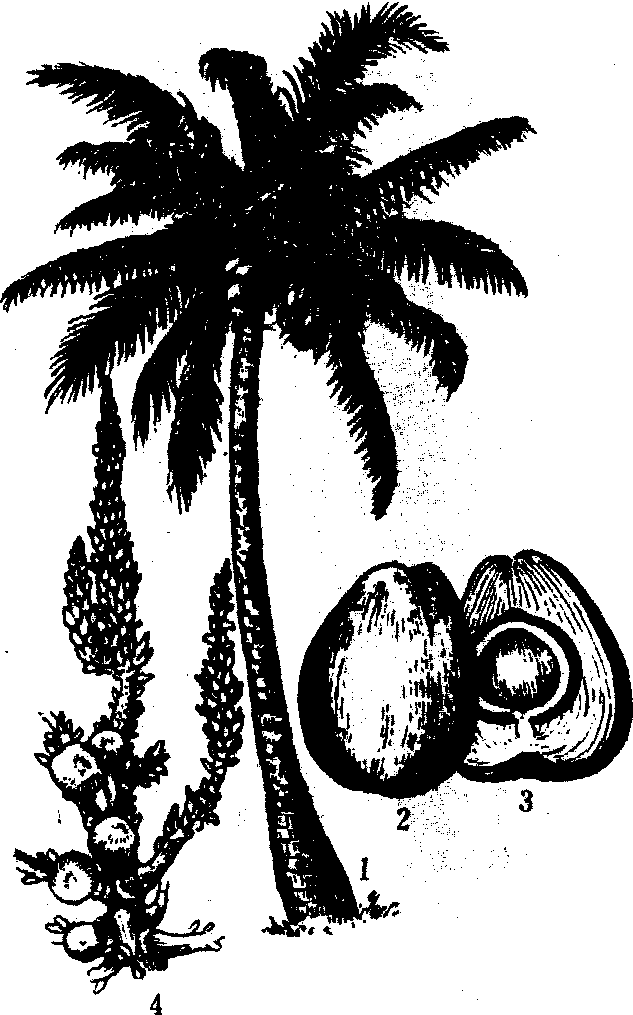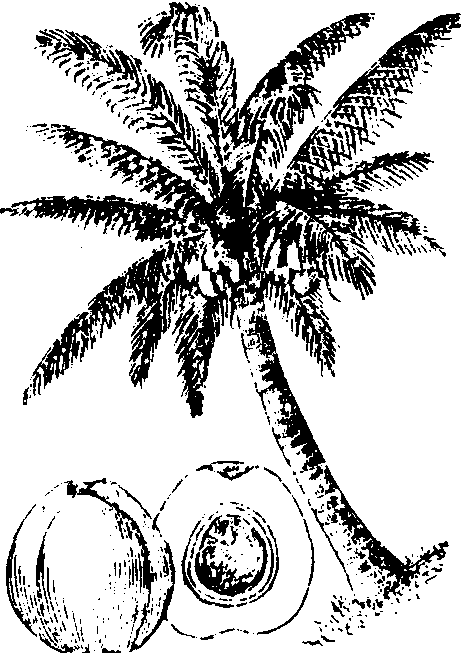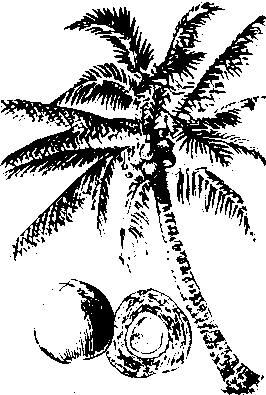椰子
椰子是深具经济价值的作物,除椰汁可饮、纤维可编成缆索、草席、床垫外,将椰肉刮出,榨成椰油,不仅可以入菜,做成糕饼、甜点,还可提炼清洁用品;椰子又是上好的景观树,成排栽种在路旁,瘦直如同标兵,南风拂过,椰影摇曳,又是一番婆娑姿态。屏东县堪称椰子王国,这里终年高温,一年四季都喝得到椰汁。在民间的观念里,椰性属凉,多饮能退火祛毒、降低血压。
椰子coconut
棕榈科椰子属常绿果树,乔木。又名胥余、越王头、椰標(台湾)。学名Cocos nu-cifera L.。
起源与分布 原产于亚洲东南部、印度尼西亚至太平洋群岛。中国栽培椰子历史悠久, 《史记》(公元前1世纪)、东方朔的《神异经》、《异物志》、郭义恭的《广志》(3世纪)等古籍已有记载。主要分布在南北纬20°以内的热带地区, 以菲律宾、印度尼亚西、印度、斯里兰卡、泰国、牙买加、墨西哥、莫桑比克、加纳等栽培较多。中国分布在海南、广东、台湾、云南、广西等省(自治区), 以海南东南沿海为主要产区。
特征与特性 高10~20米, 直立不分枝, 树干具环纹。须根系。羽状复叶长3~8米,小叶多数, 带状披针形, 先端尖, 基部背褶, 背面浅绿色, 叶柄基部具鞘状托叶,叶片螺旋状排列,每年长12片叶左右。肉穗花序生于叶丛中, 佛焰苞细长; 花单性, 每花序上部密生雄花200~300朵, 基部着生雌花1~5朵; 雄花小,花被3小3大,雄蕊6; 雌花直径2~3厘米, 球形,子房3室,通常仅1室发育。核果大, 径达25厘米,圆球形或椭球形, 未熟时青绿色, 熟时暗褐色; 外果皮革质, 中果皮纤维质, 内果皮坚硬, 基部具3孔, 种子1; 椰肉为固体胚乳,椰水为液体胚乳(见图)。椰子周年开花,海南7月至9月开花最多; 花后一年果熟。

椰 子
1. 植株; 2. 果实; 3. 果实纵剖面; 4. 花序
椰子需高温环境, 以年平均气温27℃左右, 年降水量1300~2300毫米、地下水位1~2米、相对湿度80~90%、海拔高度低于100米的地区最适, 中国年平均气温23℃的地区也适宜种植, 15℃以下的低温持续时间长会影响产量。对土壤要求不严, 以肥沃的冲积砂壤土最好,砖红壤、砂壤土和珊瑚土,pH5~9适宜。
主要品种 椰子用种子繁殖, 多异花授粉, 变异大, 分类较难。1949年纳拉扬纳(G.V.Narayana)和约翰(C.M.John.)按植株高矮和授粉形式分为两个类型,即高种椰子(Tall Types)和矮种椰子(Dwarf Ty-pes)。后来,里扬纳吉(D.V.Liyanage)认为有一个中间类型(var.anramfiaca)。
高种椰子植株高达20米, 树干基部膨大(称“葫芦头”), 异花授粉, 植后7~8年开花结果, 产量高, 椰肉厚,质量好,含油率高, 经济寿命长达70~80年。主要变种有❶蒂皮卡(var. typica)。是主要商品栽培种。
❷斯皮卡塔(var.spicuta)。花序不分枝或少分枝, 印度尼西亚称穗状椰子。
❸安得罗佩纳(Andropena)。花序多分枝。
❹马卡普纳(Makapuna)。因果腔充满可口松软的胶状体,又称实心椰子。
❺塔格纳姆(Tagna-nam)。未成熟的椰子果皮甜,可食,又称甜皮椰。
矮种椰子高5~10米,自花授粉, 植后3~4年开花结果, 果小而多, 椰肉软而薄, 含油率低, 经济寿命30~40年。主要作鲜果、杂交亲本和观赏用。由于果实和叶片颜色不同, 又有红矮、黄矮和绿矮之分。主要有两个变种: ❶那那(var. nana)。植株矮小。
❷爪哇尼卡(var. javanica)。树干较粗壮, 果实较大。
中间类型植株高度介于前两类型间, 植后7~8年结果, 自花授粉, 椰肉薄而软, 水多而甜, 主要作鲜果和观赏用。
栽培技术要点 用椰果繁殖,催芽育苗。海南高种和矮种椰子采果后40~50天发芽。西非高种和PB121杂种需90~100天才发芽。当芽长约20厘米时移入苗床或容器育苗。苗龄8~12个月、苗高80~100厘米即可选羽裂早、茎粗、叶脉明显、无畸形的壮苗在雨季初期定植。一般高种椰子每公顷植150~180株, 杂交种200~210株, 矮种椰子225~240株。植株3年生以前生长慢, 抗性差, 要及时除草施肥, 并防兽害。为充分利用土地, 可间种咖啡、可可、胡椒等作物, 也可间作豆科绿肥;或在行间种植热带葛藤等覆盖植物,以保持椰园水分, 并增施氮、磷、钾肥, 促使椰子速生快长。
中国椰子病虫害不严重, 主要有二疣犀甲为害心叶, 严重时破坏生长点, 致植株死亡。其他产椰国家严重病害主要有: 败生病, 为慢性毁灭性病害, 发现于菲律宾, 病因不明, 难防治; 致死性黄化病, 为急性毁灭性病害, 病原为类菌质体, 发现于加勒比海地区; 致死性萎蔫病,维管束被一种雏体鞭毛虫阻塞,致叶片枯萎、植株死亡, 发现于巴西、南美诸国, 无有效防治方法。在引种时必须注意上述病害的检疫。
经济价值 每100克椰子肉中含碳水化合物15克,蛋白质近5克, 维生素B1173微克, B5103微克,α-生育醇700微克, γ-生育醇750微克。主要加工成椰干、椰丝、椰块、椰片和椰油, 作糕点和糖果的原料。椰油可作食用油和人造奶油, 也可制优质肥皂, 其副产品甘油含量达12~13%。椰汁营养丰富, 可作清凉饮料。20世纪60年代以来, 用新鲜椰子湿法加工生产椰蛋白、椰奶粉、无色椰子油、椰子粉等。椰果纤维可制绳索、扫把和地毯, 和橡胶并用加工床垫、沙发垫和汽车坐垫。椰壳可加工活性炭、制乐器和椰雕等。椰树质硬花纹美, 可作家具和建筑用材。椰子综合利用的产品已达360多种。
椰子Yezi
棕榈科。乔木,高15—30米。叶大,簇生茎顶,羽状全裂,长3—4米,裂片线状披针形,长50—100厘米,宽3—4厘米。肉穗花序腋生。核果近球形,长15—25厘米,外果棕褐色,中果厚而纤维质,内果皮骨质,近基部有3个萌发孔,内含种子1粒,种皮薄,紧贴白色坚实的胚乳,胚乳内有1富含液汁的空腔。广布于热带海岸。我国海南、台湾、云南有栽培。喜高温多雨,富含腐植质的土壤生长良好。深根性,能抗风,是优良海岸防护林树种和优良绿化树种。果为热带著名佳果;椰肉(胚乳)可榨油,供食用、制高级肥皂、化妆品、机械润滑油、合成橡胶等;胚乳制成椰干、椰丝,供制糖、糕点;椰汁制饮料;椰棕(中果皮纤维)供制扫帚、地毯、绳索;内果皮供制器具、工艺品及烧活性炭;叶可编席;木材可作梁柱或伞柄;根可提染料或入药;花序可制沙糖,全身无一废物,有“宝树”之称。
椰子Cocosnucifera
单子叶植物,棕榈科。生长在热带沿海的一种常绿乔木,原产马来西亚。茎无分枝。树皮淡灰色。顶端生有很多大的羽状复叶。果实球形、椭球形或三棱形,直径约有20~30厘米。外果皮是薄硬的壳,中果皮是一层较厚纤维,内果皮木质坚硬,果腔里有1层白色胚乳,叫“椰肉”,可吃,味道甘美,芳香滑脆,含有丰富的脂肪和蛋白质。椰子糕、椰蓉月饼即以椰肉为原料制成。也可榨油。中间贮存有白色椰汁(椰乳),是一种清如水、甜如蜜的纯洁饮料。风味独特,营养丰富,含有糖类、脂肪、蛋白质、维生素C和磷、钙、铁、钠、钾等矿物质。最适于老年人饮用。我国海南省、西沙群岛、雷州半岛、台湾南部、云南西南部都有分布。

椰子
椰子
椰子是海南“四大绿宝” (椰子、橡胶、胡椒、腰果) 之一,是海南一大特产。据史料记载,从汉代起,海南就有椰子种植,至今已有2000多年历史了。椰子喜欢在热带海风吹拂的环境中生长。椰子树是常绿乔木,有高矮之分,又有青椰和赤椰之别,青椰为椰果未成熟时呈青绿色,赤椰为椰果未成熟时呈赤黄色。它一般栽培8年后开始结果,一年四季花开花落,果实不断,一株树上同时有开花、幼椰果、嫩椰果、老椰果,真是“兄弟相聚、老少同堂”,盛产期20年以上,寿命长达80年,甚至100年。盛产期每株结果多的有100多个,每年秋天是椰子收获的旺季。椰子肉、汁都是嫩的比老的好吃,汁要喝当场采摘的椰子汁为妙,并最好是在日照不强的上午10时前为最清甜解渴,中午或下午就有些酸口了。椰子用途广泛,据不完全统计,它的用途有360多种。椰肉鲜甜,营养丰富,可生食,可制成椰蓉、椰奶,可配制椰子糖,椰子酱罐头。椰子肉炖鸡是海南的佳肴之一。椰子还可酿酒。明代著名作家吴承恩在他的 《西游记》 中曾多处提到“椰子酒”,可见椰子酿酒已有很长历史了。目前海南生产的椰子酒有两种,一种是用椰乳汁冲入米曲酒配制而成的 “椰林曲香酒”,另一种是以椰子水加入白糖经过发酵而成的“椰香液”,椰子水可直接饮用,每个椰子大约有800毫升的水;椰根可入药,老椰树干可造船、架屋、制作各种家俱,厚长的羽叶可编席、织笠、盖草寮,柔韧的椰衣可制作绳索、扫把、床垫、地毡、风帆; 坚硬的椰壳既可引火、烧炭,又可做勺、制碗; 椰子油还可治疗烧伤、顽癣,是一种良药。用椰壳制成小巧玲珑的饭碗、酒盏、花瓶、粉盆、奖杯、茶叶罐,再绘以山水花果、鸟兽虫鱼,镶以锡、银或嵌以贝壳,便成为巧夺天工的美术工艺品,又是具有实用价值的生活用品。椰壳经过加工后制成的椰雕工艺品早已驰名海内外,在古代曾被作为 “天南贡品”而受到赞赏。目前海南椰雕工艺已有100多个品种。
椰子coconut
Cocos nucifera L.,棕榈科,椰子属。常绿乔木。2n=32。原产东南亚热带地区。中国的海南、广东及台湾等省区有栽培。茎干直立,无分枝,树高15~30 m。叶为巨型的羽状复叶,每小叶约100~115对,叶丛生于树干顶端,叶柄基部具网状褐色纤维。雌雄异花同株,分枝肉穗花序;雄花着生于花序上、中部;雌花着生于花序基部,子房3室,每室1胚珠,其中一个胚珠成熟。坚果圆形或扁圆形;外果皮革质,中果皮纤维质,内果皮木质,其基部有3个孔洞,为芽眼;果腔内含种仁、胚和椰乳;种仁(果肉)白色,肉质。开花一年后果实成熟,褐色。2n=32。性喜高温多雨,实生繁殖。种仁富含脂肪、蛋白质和维生素,供鲜食,也可加工成蜜饯、果酱。椰油可食用或制肥皂。椰汁可作清凉饮料。椰果纤维可制绳索、扫把和地毯。树形美观,常作观赏树。

椰子
椰子
棕榈科椰子属多年生常绿乔木。本属仅有1种。中国有2000多年栽培史。树高可达20 m。羽状复叶,具小叶片25~40片,叶长5~6 m。单性花,肉穗花序,由30~50条花枝组成。核果近球形,直径20 ~30 cm。一般10~20个成一束。果腔内含种仁、胚和乳状液体,种仁含脂肪70%。适宜生长于年平均气温26~27℃,年降水量1300~2300 mm,年光照2000 h以上,海拔50 m以下的沿海地区。年平均温度在10℃以下不易结实,0℃时受冻害。自然寿命100余年。椰子品种分高椰子与矮椰子2大类。